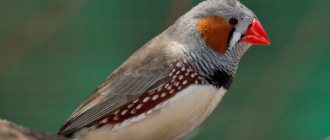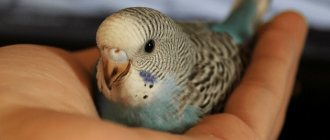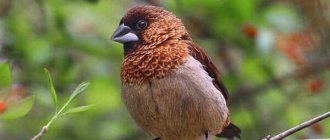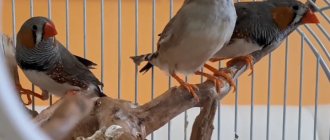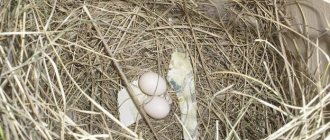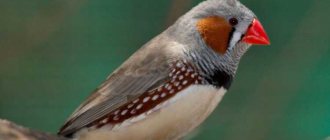The cheerful and funny finch bird is a welcome guest for those who love sonorous singing. Keeping finches does not require large financial investments or physical effort. Thanks to such unpretentiousness, combined with a peaceful character, bright songbirds have gained wide popularity. Before you bring a small feathered resident into your home, you need to find out what conditions he needs. How to prepare a room and arrange a cage, what to feed and what to do if you are sick. In addition to the basics of proper care, you should figure out whether it is possible to breed finches at home.
Red-headed Parrot Finch
Description
Finches belong to the family of weaver finches, the order of passeriformes. In nature, their habitat occupies three continents: individuals of different species are found in Africa, Australia, and South Asia. These birds are very elegant - their size does not exceed 15 cm, and their body weight is 50 g. They have a thick, triangular-shaped beak, translucent, as if cast from wax. The beak color is coral for males, orange for females, black for chicks.
The plumage palette includes a variety of shades: pastel colors in birds from temperate latitudes, bright color spots on the body of those who live in the tropics. Some finches are characterized by seasonal color changes. By the beginning of the mating season, males update their outfit, and upon completion of nesting they return to their normal color scheme.
This is interesting! Finches are considered songbirds, but their singing cannot be called outstanding. The sounds they make are more like a duck's quack.
Habitat
In nature, the zebra finch lives on the Australian mainland. Large flocks inhabit dry steppes and meadows near water, move through fields and bushes in search of food, and rest in trees. They feed on small grass seeds. With the beginning of the nesting season, zebra finches, like other bird species, unite in pairs, but do not leave the common colony. Approximately 20-25 pairs of finches from a flock nest at the same time.
The mainland variety is found throughout Australia, excluding the northern regions. The island subspecies is common on the Lesser Sunda Islands: Flores, Timor, Sumba. Wild zebra finches can also be seen in Puerto Rico and the United States, where they were brought by seafarers. In the 19th century, zebra finches appeared in Europe, but only in a domesticated state.
Popular types
Scientists count 38 species and 300 subspecies of finches. Of particular interest are those varieties that can be kept at home. Among these amazing birds, several prominent representatives of the breed stand out:
- Zebra finch. The head and neck are ash-colored, the back is brown, and the belly is light yellow. The area from the beak to the crop is painted with transverse black stripes. The tail is black with white spots. There are brick red triangles on the cheeks.
Zebra finches - Japanese finch. It was bred artificially from crossing the bronze manakan with the Chinese species of finch. The appearance is unprepossessing, but the character is balanced. Females incubate other people's eggs along with their own and are the most caring towards the chicks.
Japanese finches - Amadina Gulda. The bird is named after the wife of naturalist John Gould, who accompanied him on all expeditions. This species of finches has gained popularity due to its interesting coloring: uniform, rich shades, different in parts of the body, clear boundaries. Males sing well.
Finches Gulda - Tricolor Parrot Finches. The face mask is blue, the back and abdomen are grass-colored. The tail is crimson. The beak is dark, thickened, sharp. In captivity they are very shy, so they are kept in pairs. Aviary placement is also possible, in the vicinity of other songbirds.
Parrot finch
Selecting a diet for birds
The basis of food for finches is millet. To prepare a complete mixture for feeding these birds, you need to add 100 g of rapeseed, 100 g of chumiza, 100 g of lettuce, 250 g of meadow grass, 150 g of oatmeal, 300 g of canary seed, 100 g of hemp, 50 g of seeds per 1 kg of millet flax
The diet must include cottage cheese and boiled eggs. In the summer it will be useful to feed the finches with chopped plantain and dandelion leaves. At any time, birds should have access to mineral supplements (chalk, crushed egg shells, sea sand).
Maintenance and care
You need to understand that finches are very small and fragile birds. They should live in a cage and not jump freely around the room. Keeping feathered babies behind bars is not cruelty, but humanism, a method of protection from surrounding dangers. To keep songbirds at home, not much is required: purchase the necessary equipment, prepare a place, choose the right food.
Feeding
The diet of finches is quite simple, it does not involve any frills. It is based on a grain mixture with a predominant content of millet. Dry food also contains other components:
- hemp;
- canary seed;
- crushed oats;
- rape;
- flax and meadow grass seeds.
In addition to grain, parrot finches love raw vegetables, herbs, and berries - this is a tasty food for them, rich in vitamins. You can diversify your diet with dandelion, nettle, and plantain leaves. The exception is aromatic seasoning: dill, onion, basil.
Feeding finches only with plant products is not enough. Low-fat cottage cheese and a boiled egg are added to the daily intake of assorted grains twice a week. Food of animal origin contains calcium, phosphorus and other macroelements necessary for feather growth. The nesting period is characterized by increased energy consumption, which can be replenished with live food: mealworms, bloodworms, insects.
Attention! For proper digestion, finches require solid particles: sand, small pebbles, shell rock. Mineral feeding in the form of a special stone is a good remedy against beak deformation.
Light mode
Lighting means a lot to finches. They are harmed by both insufficient sunlight and poor lighting conditions. For breeding at home, a daylight period of at least 13 hours is required. Excessive daylight has a bad effect on the well-being of birds; bright lamps in the evening make them depressed. Lack of ultraviolet radiation is fraught with the development of rickets and metabolic disorders.
With the onset of the warm season, the cage is taken out onto the balcony or veranda, leaving it under the sun for several hours. On one side of the cage they create shade where the birds can hide. In winter, finches need an additional light source - an incandescent lamp or an ultraviolet lamp. It is preferable to use special lamps for birds, placing them no closer than one and a half meters.
Cage and accessories
The choice of cage depends on the planned number of wards. Most often, parrot finches live in groups at home, because they need company. If one pet is comfortable with a compact structure measuring 20/25/25 cm, then two or more birds will be comfortable with a spacious home. The optimal parameters for length and width are 40 by 60 cm, and the owners select the height taking into account the capabilities of the room.
The simpler the cage design, the easier it is to care for: wash, clean, change equipment. The materials from which the bird housing is made must be durable, safe, and hygienic. Finches do not tend to chew on rods, so combined housing made of metal and plastic or wood is not excluded for keeping them.
The cage is equipped with accessories:
- 2 plexiglass feeders;
- automatic drinker;
- 2 crossbars with a diameter of 9 mm;
- protective screen at the bottom along the entire perimeter.
Installing transparent protection solves the problem of debris spilling. In addition, the cage must have a tray with a retractable system. It comes with paper towels to make daily cleaning easier.
Hygiene and bathing
Water treatments are an essential part of caring for finches. But bathing a bird does not mean putting it in a bowl of water and soaping it up. The feathered pet needs to be given the opportunity to swim: install a special bathing suit - hanging or floor-standing, pour water into it so that the depth is no more than 1.5 cm. The device remains in the cage while the finches are actively splashing.
Amadin in a bathing suit
Parrot finches enjoy bathing. This is both entertainment and a way for them to care for their plumage. When in contact with water, the feathers are moistened and impurities are washed off. Water play is especially important during molting and when feather pests are present. Moisture relieves skin itching, promotes exfoliation of the epidermis, and normalizes the general well-being of birds.
Attention! Hygiene procedures are necessary for finches, but the water tank itself must be clean. After bathing, the container is rinsed well to prevent the formation of a mucous coating, dried and put away until next use.
Care during shedding
Finches molt twice a year, and this is a natural process, but it makes the birds uncomfortable. In females, molting usually occurs at the end of the breeding season. When changing plumage, finches are weakened and need increased attention. Moulting birds are subject to frequent mood swings, their appetite deteriorates, and males temporarily stop singing. To help pets cope with apathy, you need to restore their sense of comfort. To do this, a set of measures should be taken:
- ensure daylight hours of at least 10 hours;
- increase the room temperature to 26 - 28 degrees;
- maintain relative air humidity of 60%;
- allow bathing daily;
- add Tsamax to the feed according to the instructions;
- monitor the constant presence of mineral components in the cell.
Feather loss does not always occur as normal. Sometimes shedding occurs due to stress or illness. It is difficult to get rid of such a pathology; it can drag on indefinitely and even lead to the death of the finch.
Nutrition
The main diet should consist of high-quality specialized feed and mixtures of healthy cereals. The main and most useful grain is millet. It must be given daily.
Attention! Place some sand and small pebbles on the bottom of the feeder. Once in the stomach, they will help the finches grind solid food.
Amadins can also be fed:
- porridge with water;
- chalk, eggshells;
- egg yolk (no more than 1 time per week);
- vegetables, fruits and berries;
- fermented milk products (be sure to mix with cereals!);
- minced pork (also mix);
- crackers or bread (not fresh!).
Vegetables
It is very important to feed (but not more than 3-4 times a week) soft food to the birds. It contains many vitamins.
Amadins are prohibited from giving:
- milk and cheese;
- sweets and chocolate (and even more so sugar);
- products containing a lot of dyes and preservatives;
- flour products;
- fatty foods;
- products containing toxic substances (persimmon and avocado);
- onions, garlic and dill.
Millet or any grains that are not eaten by finches should be thrown away the next day and a new portion of food should be added.
If the birds have recently acquired offspring, you should buy worms or beetle larvae, since in the first month of life, finches chicks need to eat insects.
Soft food recipe. Grate 500 grams of fresh carrots and 4 medium apples. Boil 5 chicken eggs. Cut or grind ground beef, meat or heart in a meat grinder. Boil the cottage cheese for 5 minutes and strain through cheesecloth. If desired, you can add 3 tbsp. l. fresh finely chopped dandelions or nettles. Mix everything and put it in the freezer. 1-2 hours before feeding the finches, remove them and leave them at room temperature.
Birds' water should always be filled and always clean . It should be changed every day.
Milk
Diseases and prevention
Fragile finches are susceptible to specific diseases that are common to all birds. Among the characteristic avian diseases, psittacosis, internal tumors, and parasites are especially dangerous. Parrot finches also suffer from damage to the beak and feathers; They often have indigestion. Vitamin deficiency, baldness, injuries and poisoning are common phenomena in small birds, depending on the conditions of detention. To prevent complications, you should take care of your pets.
The biggest concern for owners is contagious diseases. Pet finches can pick up infections, mites, or fungi from new ones purchased at a pet store. Typical signs of a viral infection: changes in behavior, drowsiness, refusal to eat. But these same symptoms can be a manifestation of any other disease. If there is a suspicion that the pet is unwell, it is shown to the veterinarian. Reducing the likelihood of infection is easier than treating it, so quarantine is necessary for feathered newcomers.
Kimberly
Not during the nesting period of Gouldian finches, they can be found in the coastal area: here, due to long rains, there is a lot of food for food. With the rainy season, bird migrations may begin as water bodies and vegetation dry up. The grains that fall from the panicles can only be found on the ground. During such periods, females abandon chicks and eggs.
The Kimberley region is the hottest area in Australia. During the day, the temperature here can reach 40-45 degrees Celsius in the shade, and at night it rarely drops below 35 degrees. November and April are the time of heavy rains. During this period, air humidity can be at the level of 80-90%. But Gouldian finches have adapted perfectly to such a climate. At temperatures of 30-45 degrees Celsius, birds are very active. At this time, they can look for grains for food.
Breeding at home
By analogy with budgies, finches easily reproduce in captivity. Their sexual instinct first appears at the age of 7–9 months. Breeders agree that early breeding should not be encouraged - let the female grow up to at least a year. If the owner is interested in obtaining offspring from his charges, he must place a couple of birds in a separate cage in time. In a new home, you should hang a nesting house and provide the pets with material for building a nest: twigs, hay, dust. In one year, finches have up to three broods, but if they nest so often, the female’s body may not be able to withstand it. Sometimes tired birds abandon their chicks or die from exhaustion.
Amadin abilities, how to tame
Finches, unlike parrots, are timid birds and not at all so tame. They must be approached carefully, movements must be smooth and slow. Sharp sounds and noises in a room with a bird (which can even cause the finch to die) are unacceptable. After some time, the bird will get used to it and taming can begin.
How finches sing
Among finches, it is predominantly males who sing. The singing of finches is used both to attract females to mating, and when everything is fine with them: they are well-fed, suitable conditions for keeping have been created and contact has been established with the owner. But regarding the quality of the birds’ singing, the reviews of the owners differ greatly - some can listen to the finches singing with pleasure, finding their trills pleasant and melodic, while others, on the contrary, consider the singing dull and monotonous.
Listen to how they do it:
Taming
An important condition for successfully taming a finch is its age. The younger the bird, the easier it is to train. Adult birds have already formed characters and established habits, which they are extremely reluctant to change.
Attention! You can only tame one finch; two or more individuals will distract each other.
How to quickly tame a finch - just release it to freedom. One day, upon entering the room, the owner will see how the feathered pet is breaking out of its cage into freedom. This will mean that the bird has become tame.
- The first step is to move the student into a separate cage, small in size, with an opening side wall or a folding top.
- To prevent the finch from being injured by hitting a window glass or getting stuck in a ventilation grill, or accidentally flying out of the window, the bird’s wings need to be clipped.
- Next, you need to force the finch to sit on the owner’s hand. To do this, carefully, without sudden movements, the bird is driven into the corner of the cage and a hand is placed in such a way that the finch simply has nowhere to go except to jump on it.
- The final stage will be attempts to pull the hand with the finch sitting on it out of the cage. If the bird gets scared and flies away, it should be left for several hours to calm down, and then the experiment should be repeated.
To get the finch accustomed to its surroundings, it is placed on the shoulder. After some time, you can try to put your finger on the bird, lightly touching the bird’s legs. In this way, she will learn to move from shoulder to arm and back.
Important! In order for the finch to associate the space outside the cage with a safe place, you need to install a play stand or a corner with several perches in the room.
Interesting information about taming finches is described in this video:
Caring for chicks
After mating games, the female sits in the nest and lays 2–5 white eggs. She warms the clutch during the day alternately with the male; at night the finches sit together on the eggs. After 12 - 16 days, the chicks appear, naked, blind and helpless. The parents feed them partially digested food, which is regurgitated from the crop into the beaks of the young. On the third day, the chicks begin to develop fluff, the first sounds appear - a voice emerges.
The features of caring for finches chicks do not differ from those required for any birds. The young begin to fly after three weeks and try to fly out of the nest. At this time, the brood must be diligently monitored and returned to its parents after a fall. It is recommended to secure several thin perches near the nest, on which the chicks will learn to jump and take off. It is possible that by the time the young birds are placed in another cage, the female will begin nesting again.
Exotic birds, finches, are capable of delighting people with just their appearance. And if they start singing and taking food from their hands, no one remains indifferent. You shouldn’t expect the same emotional response from these birds as from parrots, but the serene twitter of finches creates a very cozy atmosphere in the house.
Price
The zebra finch is a very popular and easy to keep bird. Chicks of this species have a high survival rate, which is why there are always cute “strikes” on sale. Breeders sell small zebriks and set the price based on external beauty, purity of the breed and health of the bird. You can buy a bird from a private person for 300 rubles, and in a nursery you can get a ringed chick with a pedigree and vaccinations for a price of 1,500 rubles.
We talked about smart and charming birds, learned their characteristics and habits, and learned the basics of care, maintenance and feeding. The zebra finch is the best choice if you want a cheerful pet that doesn't need too much human interaction. If you liked the article or have something to add, then leave your comments and also join our VKontakte group.



